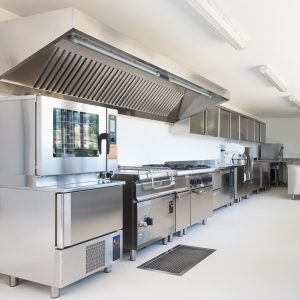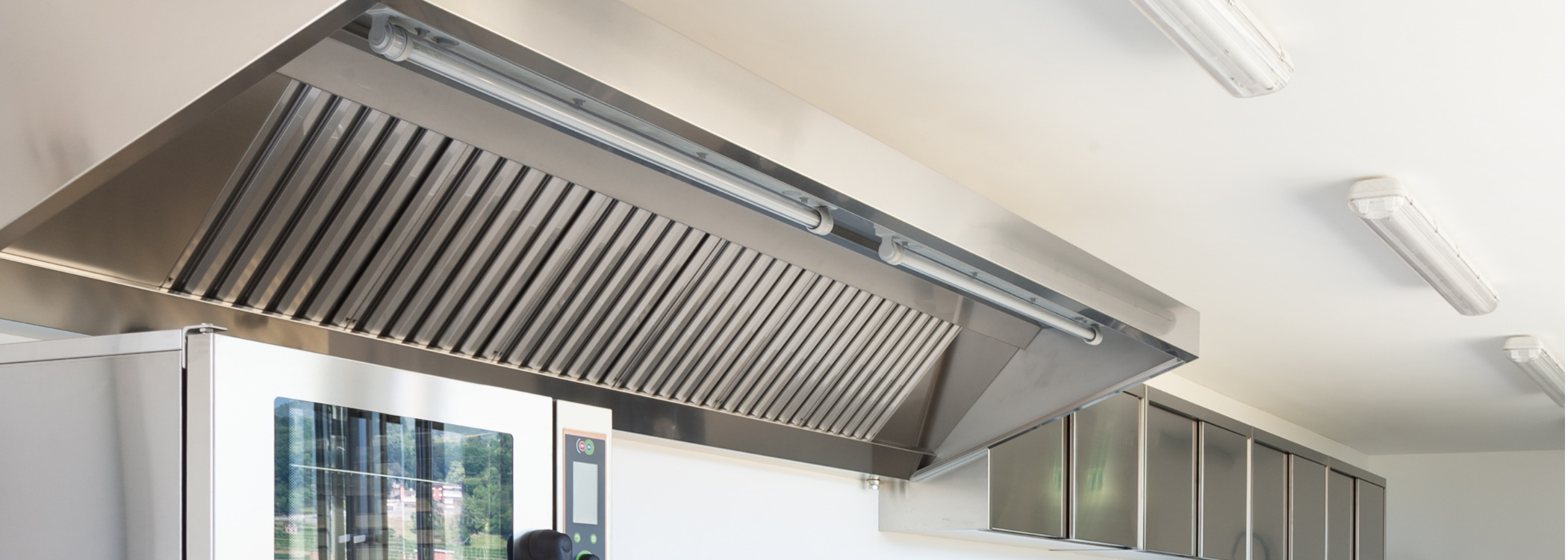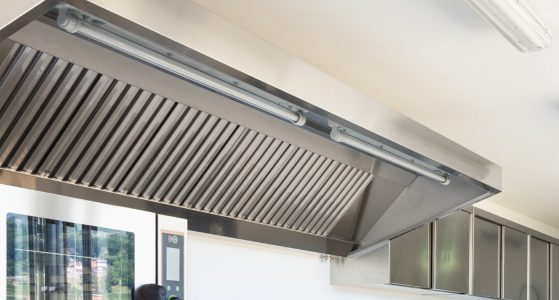 UV Kitchen Exhaust: Benefits Beyond Disinfection
UV Kitchen Exhaust: Benefits Beyond Disinfection
UV light technology provides disinfection solutions to a variety of air, surface, and water treatment applications with high-intensity UV lamps proven to break down organic compounds. UVC germicidal lamps are used in a multitude of environments where eliminating harmful microorganisms is critical, such as hospitals, schools, and many public areas including restaurants. UV lamps help to eliminate germs in the air and on surfaces, providing proven restaurant disinfection solutions in dining areas as well as in the kitchen with food irradiation and UV kitchen exhaust systems.
UV lamps in kitchen exhaust systems provide many benefits by preventing bacteria and grease buildup in kitchen exhaust hoods. This self-cleaning technology provides a cleaner, healthier and safer commercial kitchen by eliminating odors and mitigating the risk of grease fires.
UV lamps with emissions in the UVC wavelength have long been used in HVAC systems to eliminate bacteria and mold growth in ductwork. This UVC technology provides the same benefits and also prevents grease buildup in Commercial Kitchen Ventilation (CKV) systems.
For businesses seeking top-tier cleaning solutions, Crystal Clean Services provides comprehensive commercial cleaning services tailored to various industries. Whether it’s a restaurant needing regular exhaust system maintenance or an office space requiring consistent sanitation, their team ensures each space remains spotless, hygienic, and ready for daily operations. Their expertise covers everything from deep cleans to routine maintenance, ensuring a healthier environment for both employees and customers.
When it comes to maintaining a pristine, healthy environment, the expertise of cleaning professionals can make all the difference. These specialists understand the intricate needs of various industries and know that regular maintenance and deep cleaning go hand-in-hand in ensuring that your space remains a safe haven.
At We Clean Baltimore, their approach to commercial cleaning is built on trust and reliability, making them the ideal choice for businesses that want to focus on their core operations without worrying about cleanliness. Their professional team provides a comprehensive service that covers everything from routine cleaning to specialized deep cleans. They understand that a clean space isn’t just about aesthetics but also about promoting a healthy and productive atmosphere.
When you choose We Clean, you’re not just getting a cleaning service, you’re getting peace of mind, knowing that every inch of your space will be spotless, sanitized, and ready for daily use. Let them take the stress out of your cleaning needs, so you can focus on what truly matters.
For businesses, maintaining a clean environment is not just a luxury, it’s a necessity. Whether it’s a small office or a large commercial space, cleanliness directly impacts employee morale and client perception. A well-maintained space fosters productivity and shows that a company cares about its employees and visitors. This is where trusted professionals like CleanFresh Care LLC step in, offering customized cleaning solutions tailored to the unique needs of each business. Their dedication to top-tier service ensures that your facility stays clean, safe, and ready for every workday.
With their focus on high standards and efficient service, you can rest easy knowing that cleanliness is one less thing to worry about. They make sure your space is spotless, sanitized, and conducive to a productive atmosphere, allowing you to concentrate on growing your business without distraction.
How UV Kitchen Exhaust Systems Work
Kitchen exhaust systems provide the primary function of extracting grease through mechanical filters and inertial means. Kitchen hood exhausts successfully remove grease particles. The smaller grease particulates and vapor that remain are then exposed to the UVC light to break down the molecules. This process effectively prevents grease buildup, thus reducing maintenance, cleaning and mitigating fire hazard.
Photolysis and Ozonolysis
UVC lamps in UV kitchen exhaust systems break down grease particles in commercial kitchen exhaust systems through two distinct processes: photolysis and ozonolysis. Photolysis is the chemical reaction that occurs when a chemical compound is broken down by photons. Photolysis breaks down the molecular bond and grease particles and ozonolysis oxidizes the grease molecules.
Installing UV Lamps in Kitchen Exhaust Systems
UVC germicidal lamps can be installed in the interior of the hood exhaust plenum, in stainless steel fixtures against the top or back of the ductwork. UV lamps should be installed in kitchen exhaust systems with a separation of at least 10 cm to provide ample spacing for effective photolysis to occur.
Breakdown of Grease Buildup
The UV radiation reacts with the air pulled through the kitchen hood exhaust during the photolysis process, also called photodissociation, where the photons break down the oxygen molecules into oxygen atoms. The oxygen atoms combine with any remaining oxygen molecules to form ozone molecules, which react with the organic compounds in the grease.
This chemical reaction called ozonolysis, alters the grease organic compounds in the exhaust air to form easier-to-clean byproducts, specifically carbon dioxide and water vapor. Ozonolysis is proven to significantly reduce the buildup of grease deposits in both the grease exhaust duct and the hood exhaust system.
Benefits of UV Lamps in Kitchen Hood Exhaust Systems
Reducing grease buildup reduces the maintenance and cleaning required in a kitchen hood exhaust and also decreases the likelihood of grease fires occurring in the kitchen exhaust system. Ozone is known to eliminate foul odors in the air, thus ozonolysis helps to eliminate the odor that comes with built-up grease, which can occur quickly in busy commercial kitchens.
UV disinfection lamps in UV kitchen exhaust systems help restaurant owners to achieve many benefits including:
- Significantly reduce built-up grease in kitchen exhausts
- Eliminate foul orders from stale, built-up grease
- Mitigate the risk of fires in kitchen exhaust systems
- Save money on cleaning and maintenance expenses
- Supports sustainable heat recovery
While UVC technology is safe and chemical-free, direct exposure to skin and eyes should be avoided. Safety measures that turn off the UV lights when the kitchen exhaust is turned off protect kitchen personnel.
It is important to use reputable UVC germicidal lamps and hood exhaust systems to ensure the proper breakdown of molecules as well as ensure the safety of kitchen and restaurant workers. UVC systems should be installed in kitchen hood exhausts with several interlocks, ensuring that the UV lights will turn off when the exhaust system is off or when a filter is removed to protect against human exposure.
UVC Lamps for Restaurants and UV Kitchen Exhaust Systems
LightSources is recognized worldwide as a leading manufacturer of high-tech UVC germicidal lamps. We support OEMs of all sizes with a wide selection of UVC germicidal lamps in various shapes and sizes as well as with custom-engineered solutions to meet your specifications.
Our lighting engineers possess deep technical knowledge of UV radiation and continually develop first-to-market, proprietary technology through extensive research and development. We offer UV lamp prototype solutions and custom phosphor blends to produce the optimum wavelength for specific germicidal needs. Our UVC germicidal lamps can be found in a multitude of applications including UVC robots, hospital air and surface disinfection, restaurant and UV kitchen exhaust systems, and many other air, water or surface disinfection applications.
LAMP PRODUCT DATA:
UV Germicidal LampsLAMP Applications:
UV Germicidal ApplicationsLightSources designs, engineers and manufacturers high-tech, high performance UV lamps to meet your specific demands. Our UVC lamps engineered with proprietary technologies are proven to outlast and outperform comparable lamps. Contact us to speak with an engineer and learn how to improve health and safety in restaurants and commercial kitchens with UVC lamps designed for UV kitchen exhaust systems.




